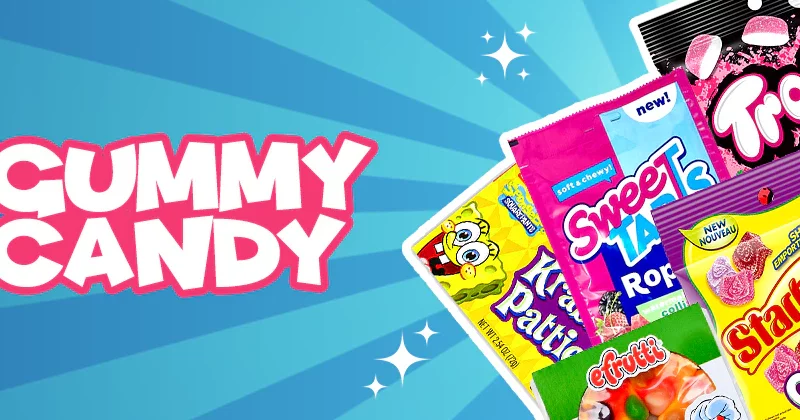Introduction
The gummy candy market has witnessed robust growth over the past decade, transforming from a children’s treat into a versatile confectionery category that appeals to consumers of all ages. This shift is driven by innovations in flavor, texture, packaging, and the incorporation of health-oriented ingredients. As consumer preferences evolve toward convenient and indulgent snack options, gummy candy continues to enjoy rising global demand across both traditional and functional product segments.
This article explores the current dynamics, growth drivers, challenges, key players, and future outlook of the gummy candy market through 2033.
Market Overview
In 2024, the global gummy candy market was valued at approximately USD 18.6 billion and is projected to grow at a compound annual growth rate (CAGR) of 5.2%, reaching over USD 30.2 billion by 2033. Growth is primarily fueled by product diversification, increasing health-conscious variants, and expanding distribution channels.
Key Market Drivers
-
Flavor and Texture Innovation
Gummy candies have expanded beyond the traditional fruity flavors to include sour, spicy, cola, yogurt-infused, and even dual-texture varieties. Unique formulations and exotic flavors attract new consumer segments and encourage repeat purchases. -
Rising Demand for Functional Gummies
Gummy candies are increasingly used as delivery systems for vitamins, minerals, and nutraceuticals. This crossover with the wellness sector appeals to adults looking for enjoyable yet health-focused snacking solutions. -
Expanding Distribution Channels
Wider availability in supermarkets, convenience stores, e-commerce platforms, and vending machines enhances market reach. Online retail is especially significant for niche, premium, and health-oriented gummy products. -
Youth-Centric Branding and Packaging
Colorful, playful branding and resealable packaging options appeal to children and young adults, driving repeat purchases. Limited-edition releases and character-themed packaging also boost impulse buying. -
Growing Middle-Class Population in Developing Economies
Rising disposable incomes in regions like Asia-Pacific, Latin America, and the Middle East have contributed to increased consumption of affordable indulgences, including gummy candy.
Market Segmentation
-
By Product Type
-
Traditional Gummies (fruit, cola, sour, sweet)
-
Functional Gummies (vitamin-enriched, probiotic, CBD-infused)
-
Vegan and Organic Gummies
-
Sugar-Free and Low-Calorie Gummies
-
-
By Flavor
-
Fruit Flavors (berry, citrus, apple, watermelon)
-
Cola and Beverage-Inspired Flavors
-
Yogurt and Dairy-Inspired Flavors
-
Novelty and Exotic Flavors (mango chili, lychee, lavender)
-
-
By Distribution Channel
-
Supermarkets and Hypermarkets
-
Convenience Stores
-
Online Retail
-
Specialty Stores
-
Pharmacies (for functional variants)
-
-
By End User
-
Children
-
Teenagers
-
Adults (wellness-oriented and indulgent consumers)
-
Regional Insights
-
North America:
Dominated by functional gummy sales, particularly in the U.S. where adult consumers are drawn to vitamin and supplement gummies. Seasonal themes and Halloween-related offerings are also strong market drivers. -
Europe:
Home to major gummy manufacturers, Europe emphasizes quality and ingredient transparency. Germany, the UK, and France are key consumption hubs with growing interest in organic and vegan gummies. -
Asia-Pacific:
Rapid urbanization and expanding retail infrastructure are driving market growth in China, India, and Southeast Asia. Regional preferences for unique textures and flavors influence product development. -
Latin America:
Countries like Brazil and Mexico show growing interest in fruity and sour gummies, supported by young demographics and increasing retail access. -
Middle East & Africa:
The market is at a nascent stage but showing potential due to increasing urban populations and the growing influence of Western snacking trends.
Technology and Innovation Trends
-
Gelatin Alternatives and Plant-Based Gums
With rising veganism and halal/kosher dietary requirements, manufacturers are investing in pectin, agar-agar, and starch-based formulations. -
Functional and Medicinal Infusions
Gummy candy infused with vitamins, collagen, CBD, melatonin, or probiotics is gaining popularity, especially among adults seeking health benefits. -
Personalized Gummies and 3D Printing
Custom gummy designs, flavors, and supplement combinations are becoming feasible through advances in food tech and digital customization platforms. -
Sustainable Packaging
Manufacturers are moving toward biodegradable and recyclable packaging materials to align with consumer eco-consciousness.
Challenges
-
Health Concerns and Sugar Content
Gummy candies often face criticism for high sugar content. This has pushed manufacturers to reformulate recipes using alternative sweeteners, though taste remains a challenge. -
Seasonality and Impulse-Driven Sales
The market heavily depends on seasonal spikes (e.g., Halloween, Easter), making consistent year-round sales difficult for some brands. -
Regulatory Compliance in Functional Gummies
Products that cross into supplement territory must adhere to strict regulatory guidelines across different markets, impacting formulation and marketing. -
Vegan and Clean Label Expectations
As consumer demand for transparency grows, companies must source and disclose clean, ethical, and allergen-free ingredients.
Competitive Landscape
The market is moderately fragmented with a mix of legacy confectionery brands and newer health-focused entrants. Leading players include:
-
Haribo
-
Ferrara Candy Company (Ferrero)
-
Mars Inc.
-
Mondelez International
-
Albanese Confectionery
-
Jelly Belly
-
The Hershey Company
-
SmartyPants Vitamins
-
Olly Nutrition
Many traditional candy brands are diversifying into functional and low-sugar segments, while wellness brands are entering the market with supplement-infused gummies.
Future Outlook (2025–2033)
-
Steady Growth Across All Segments: Both indulgent and functional gummy categories are expected to grow steadily, with functional variants gaining a faster share.
-
Expansion in Emerging Markets: Manufacturers will increasingly target middle-income countries where urbanization and retail expansion support growth.
-
Hybrid Product Categories: The convergence of candy and health supplements will continue to blur boundaries and create novel gummy formats.
-
Premiumization and Personalization: The market will witness a rise in premium, limited-edition, and customizable gummy products that offer unique value propositions.
Source: https://www.databridgemarketresearch.com/reports/global-gummy-candy-market
Conclusion
The gummy candy market is evolving rapidly, driven by innovation in flavors, formats, and functional benefits. While traditional gummies remain popular, the emergence of wellness-infused, vegan, and sugar-free options is redefining the category. With consistent global demand and a strong pipeline of product innovation, the market is well-positioned for long-term growth. Brands that focus on health-conscious offerings, sustainability, and digital engagement will lead the next wave of expansion in this dynamic market.












